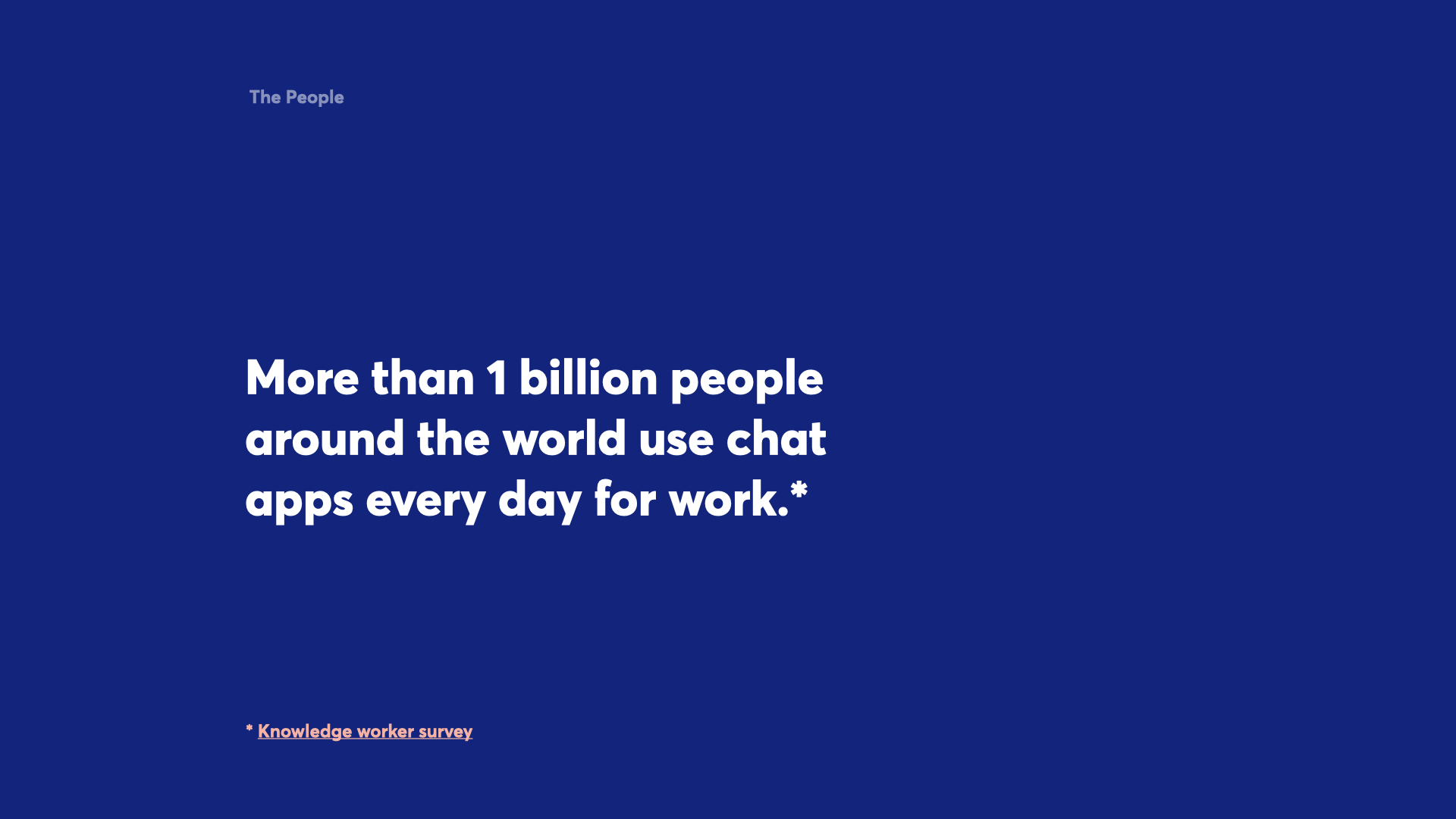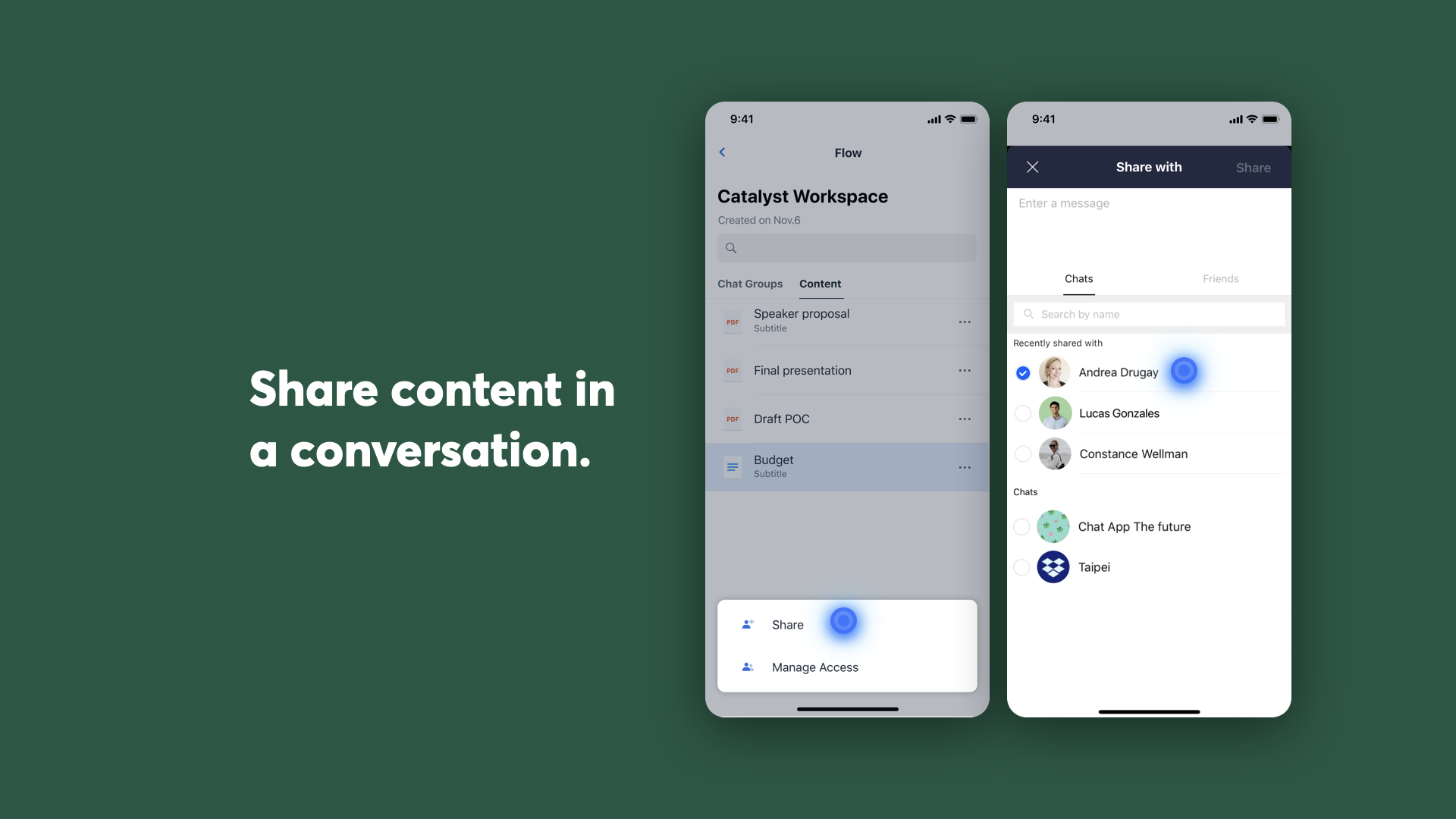Background
I'll be using the contents of the pitch deck that I created and presented to the CEO Drew Houston, VP Timothy Young, and VP of Design Alastair Simpson, for this case study.
During Dropbox's 2019 summer hackweek, our team pursued an opportunity identified by our Head of International Research. In just one week, we built and shipped a prototype, tested it with users in Japan and Indonesia, won an award, and progressed towards securing funding and a patent.
Our Head of International Research, Jen DiZio, conducted extensive research on global work habits and tools, drawing from her experience at Facebook, WhatsApp, and Instagram. We discovered that over 2.5 billion people worldwide use chat apps daily, with over 1 billion using them for work. Interestingly, most users rely on consumer chat apps like Line, WhatsApp, and Facebook Messenger, rather than dedicated work apps like Slack or Teams.
We identified key pain points through user feedback and quantitative studies, finding three features that were deemed "most important" by over 80% of respondents.
Top 3 Existing Needs
- Storing files across multiple conversations.
- Searching for files across multiple conversations.
- Storing comments and decisions across multiple conversations.
After a significant competitive audit, we recognized that no one was directly addressing these customers' needs while meeting them where they are. Consumer apps like Line prioritized personal conversations, while work apps like Slack avoided the personal aspect. Both aimed to pull users away from consumer chat apps into their own apps. However, SMBs and freelancers outside the US, prefered to keep work and personal communication integrated, leading to the use of multiple chat apps simultaneously. This discrepancy created an opportunity, which is where Dropbox Flow came in.
Background Slides






















Planning
During Fall Hack week in 2019, we set out to solve these problems with one making sure to follow our only principle: "meet the users where they are." I put together a small cross functional team to take advantage of the opporunity we saw infront of us.
Contributors
- Jason Ramirez (me)
- Jen DiZio
- EJ Reckers
- Ming Li
- Yenchi Linn
Designing
We built a prototype that solved for our user's problems and tested it with potential customers in Japan and Taiwan. Here are some of the reactions:
The people we talked with hadn’t seen anything like this before. They were excited and the validation was promising. Our next step was to put together a pitch to request funding to start on an MVP. Our MVP launch would start with 4 in-chat features and 5 out-of-chat workspace features. These features focused on the 3-big needs: storing files across multiple chats, searching for files across multiple chats, capturing important decisions.
In-Chat MVP Feature Set
- Add Flow from a conversation.
- Connect a conversation to a workspace.
- Automatically store files to a workspace.
- Capture important decisions.
For greater control, we have 5 workspace features.
Flow App Experience
- Setup and organize a workspace.
- Add multiple conversations to a workspace.
- Search across conversations and workspaces.
- View, preview and retrieve content.
- Share content in a conversation.
Our MVP tackled the major pain points we'd heard our customers say. Here are slides for the solution portion of our pitch:
Integration Into Chat Apps




Flow App





The Impact
Our validation rounds provided direction and instilled a "meet the customer where they are" mindset at Dropbox. This mindset expanded to other ideas, focusing on supporting customers within their existing workflows. We pitched a series of fast-follow concepts, leveraging browser extensions, app integrations, and methods like email to Dropbox, avoiding the need for a new app.
The prototype, validation, and pitch secured 6 months of funding from Dropbox's internal incubator, Dynamo, for a team of 4 members. We assembled a cross-functional team to drive the project towards its first milestone.
As a result of our work, we successfully applied for and were granted a patent. The legal team at Dropbox supported us in filing for a patent for our cloud-based storage solution bridging a chat application. We received the patent in 2020.
The Challenges
Within 3 weeks of securing funding, I went on paternity leave and the lead Product Manager, EJ, left Dropbox. As a result, the project lacked inspired leadership and expertise to drive it forward. We attempted to establish a contingency plan, but it became evident that the necessary skill level was not readily available within Dropbox. Consequently, the project funding was redirected to a different project with a tangential value proposition, and our project officially transitioned away from its original purpose.
Learnings
Our biggest failure was the lack of a solid plan for continued leadership. Despite being aware of my upcoming leave and the Product Manager's departure, we failed to adequately staff the project or identify alternative leadership to ensure progress towards our first milestone. It was a valuable lesson in the importance of proactive planning to maintain leadership and momentum.
Closing
During Dropbox's 2019 summer hackweek, our team pursued an opportunity identified by our Head of International Research. We built and shipped a prototype, tested it with users in Japan and Indonesia, won an award, and made progress towards funding and a patent. Our project aimed to address key pain points in chat app usage for work, bridging the gap between consumer and dedicated work apps.
The impact of our work was evident as we secured funding from Dropbox's internal incubator and successfully applied for a patent. Our project contributed to a mindset shift within Dropbox, emphasizing the importance of meeting customers where they are and supporting them within their existing workflows. Although we faced challenges with leadership and staffing, this experience taught us valuable lessons about proactive planning and sustaining momentum.